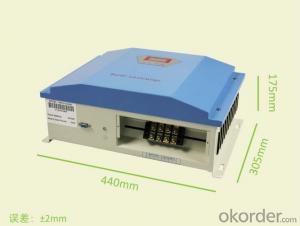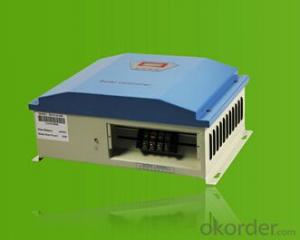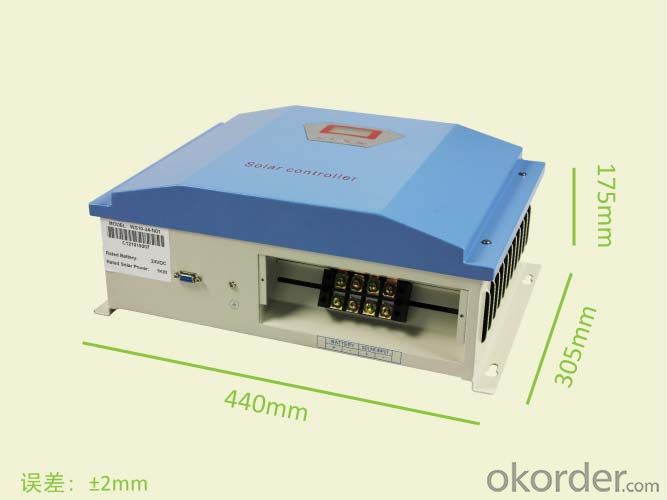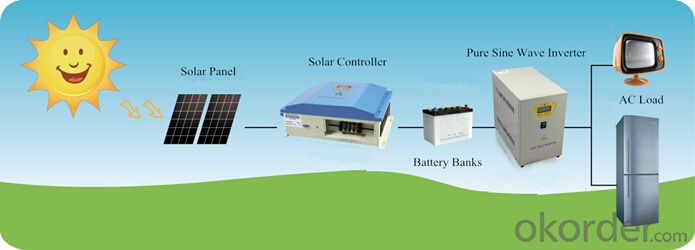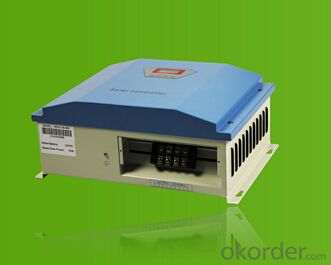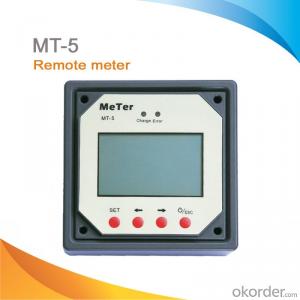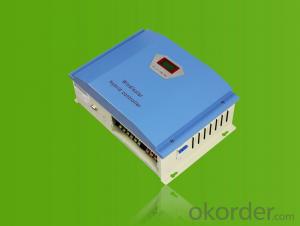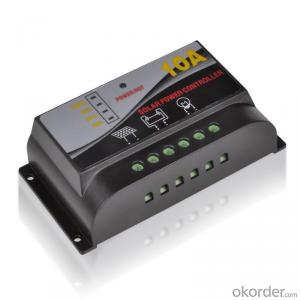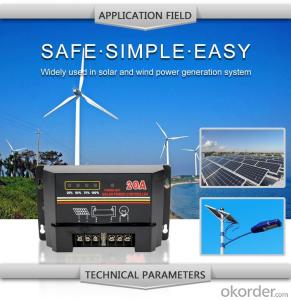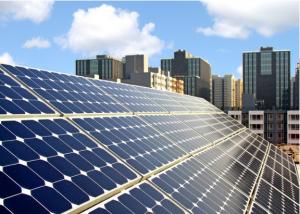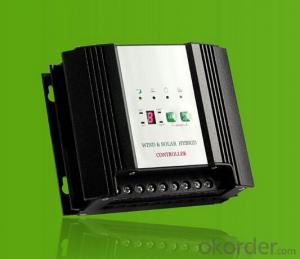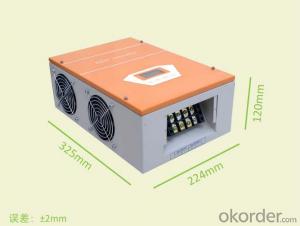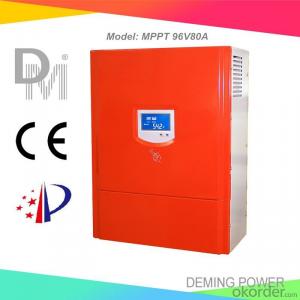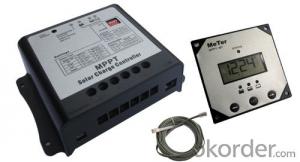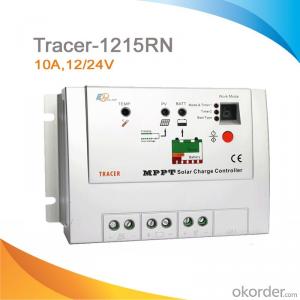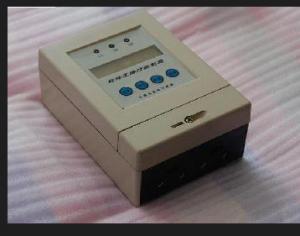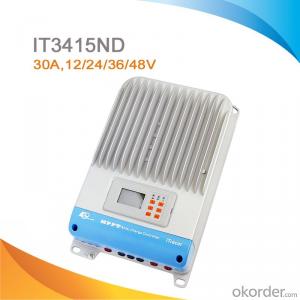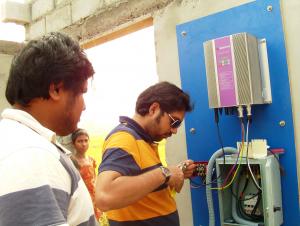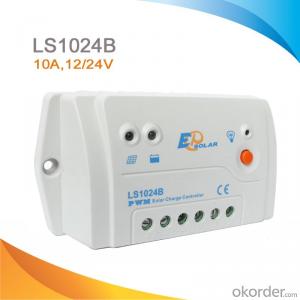Solar Power Controllers - 10kW MPPT Solar Charge Controller with Charging Function
- Loading Port:
- Shanghai
- Payment Terms:
- TT or LC
- Min Order Qty:
- 1 unit
- Supply Capability:
- 10000 unit/month
OKorder Service Pledge
OKorder Financial Service
You Might Also Like
I. PRODUCT INTRODUCTION
Solar controller is control device which can control solar panel and transform solar energy into electricity then store to the battery bank. Solar controller is the most important part in off-grid system, whose performance has much effect on life expectancy and operation of the whole system, especially the battery expectancy. Or battery service life will be shortened by over charge or over discharge.
II. PERFORMANCE FEATURES
Superior military-grade components to ensure the product stability.
Perfect protection function, thus the system has higher reliability.
Check and set all operation parameters as requirement from LCD display.
III. APPLICATION AREAS
Standalone Domestic household photovoltaic power system
Mobil communication base stations, expressway and other non-residential regions.
Coastal islands, remote mountainous, border posts for regions shortage of or without electricity.
Government demonstration projects, landscape lighting project etc.
IV. 10KW TECHNICAL PARAMETERS
Product Model | WS100-120-N00 | WS100-220-N00 | WS100-240-N00 |
Rated battery power | 120V | 220V | 240V |
Rated solar input power | 10kW | 10kW | 10kW |
Floating charge voltage | 145V | 266V | 290V |
Max Open Circuit Voltage | 250V | 458V | 500V |
Dimensions (L x W x H) | 442×307×172 mm | ||
Net Weight | 8kg | ||
Display mode | LCD | ||
Cooling | Fan | ||
Protection Level | IP20(Indoor) | ||
Quiescent current | ≤20 mA | ||
Protection functions | Battery over charge; battery anti-reverse-connection; solar reverse charge protection; solar anti-reverse-connection; lightning protection. | ||
Ambient temperature | -20~+55℃ | ||
Ambient humidity | 0~93%,without condensing | ||
Working altitude | ≤4000m | ||
In order to serve our customers better, our company can adjust parameter configuration according to customer’s requirement. | |||
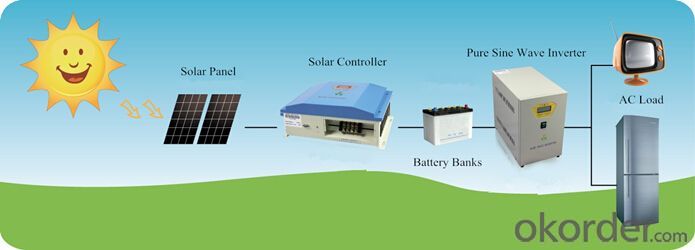
- Q: How do I determine the maximum solar panel input current for a solar controller?
- To determine the maximum solar panel input current for a solar controller, you need to consider a few factors and perform some calculations. Here are the steps you can follow: 1. Check the specifications of your solar controller: The maximum solar panel input current is usually mentioned in the product specifications provided by the manufacturer. Look for the "Max Input Current" or "Max PV Current" rating. This value represents the highest current that the solar controller can handle. 2. Determine the maximum current rating of your solar panels: The maximum current rating of your solar panels can typically be found in their specifications or datasheet. Look for the "Imp" (maximum power current) or "Isc" (short-circuit current) rating. This value represents the maximum current that the solar panels can generate under optimal conditions. 3. Consider the total number of solar panels in your system: If you have multiple solar panels connected in series or parallel, you need to account for the combined current they generate. For series connections, the current remains the same, but for parallel connections, the current adds up. 4. Check the voltage compatibility: Ensure that the voltage output of your solar panels aligns with the voltage input range of your solar controller. If the voltages don't match, you may need to use a voltage converter or select a different solar controller. 5. Perform calculations: Multiply the maximum current rating of a single solar panel (Imp or Isc) by the number of panels in the system. If you have parallel connections, add up the currents, but if you have a series connection, the current remains the same. 6. Compare the calculated current with the maximum input current rating of the solar controller: If the calculated current is lower than or equal to the maximum input current rating of the solar controller, then it is compatible. However, if the calculated current exceeds the maximum input current rating, you will need to either reduce the number of panels or select a different solar controller with a higher input current rating. Remember to always consult the product manuals, datasheets, or contact the manufacturer for accurate and specific information regarding your solar panels and solar controller.
- Q: Can a solar controller be used in a solar-powered submarine?
- Yes, a solar controller can be used in a solar-powered submarine. A solar controller manages the flow of electricity from the solar panels to the batteries, ensuring that the batteries are charged efficiently and preventing overcharging. In a solar-powered submarine, the solar controller would be essential for regulating the power generated by the solar panels and storing it in the batteries to power the submarine's systems and propulsion.
- Q: How does a solar controller prevent battery over-temperature?
- A solar controller prevents battery over-temperature by monitoring the temperature of the battery and regulating the charging current accordingly. It uses temperature sensors to constantly measure the battery temperature and adjusts the charging voltage and current to prevent overheating. This ensures that the battery operates within a safe temperature range, prolonging its lifespan and preventing any potential damage or failure.
- Q: What is the role of a solar controller in preventing battery overcharging?
- To prevent battery overcharging, the flow of electricity from the solar panels to the battery bank is regulated by a solar controller. When sunlight hits the solar panels, they produce electricity, which must be carefully managed to avoid overcharging the batteries. Acting as an intermediary, the solar controller, also referred to as a charge controller, monitors the voltage and current levels from the solar panels. It then adjusts these levels based on the battery's charge status. When the batteries reach full capacity, the solar controller restricts or completely stops the electricity flow from the panels to prevent overcharging. Overcharging the batteries can result in negative consequences such as decreased battery life, heightened maintenance needs, and potential safety hazards like explosions or fires. By preventing overcharging, the solar controller promotes the longevity and efficient operation of the batteries. Moreover, the solar controller may include additional features like temperature compensation. This feature adjusts the charging voltage based on the battery's temperature, further optimizing the batteries' performance and lifespan. In conclusion, the solar controller's main role in preventing battery overcharging is to regulate the flow of electricity from the solar panels to the batteries. This ensures the batteries are charged in the best and safest way possible.
- Q: What is the power of the solar controller?
- The solar controller is represented by the maximum available current
- Q: How does a solar controller handle shading on the solar panels?
- A solar controller handles shading on the solar panels by utilizing a technique called Maximum Power Point Tracking (MPPT). This technology allows the controller to constantly monitor the output of each individual solar panel and optimize the power generation by adjusting the voltage and current levels. When shading occurs on a certain panel, the MPPT controller communicates with the other panels to ensure that they continue to operate at their maximum capacity, minimizing the impact of shading on the overall system performance.
- Q: How does a solar controller prevent damage from power spikes?
- A solar controller prevents damage from power spikes by regulating and stabilizing the flow of electricity from the solar panels to the battery. It acts as a barrier between the solar panels and the battery, ensuring that only the appropriate voltage and current are supplied to the battery, thus protecting it from potential damage caused by power spikes or surges.
- Q: Can a solar controller be used with solar-powered fans?
- Yes, a solar controller can be used with solar-powered fans. A solar controller helps regulate the voltage and current from solar panels, ensuring optimal performance and preventing damage to the fans. It allows for efficient charging and utilization of solar energy to power the fans effectively.
- Q: How does a solar controller prevent damage to batteries?
- A solar controller prevents damage to batteries by regulating the charging process and ensuring that the batteries receive the appropriate amount of voltage and current from the solar panels. It prevents overcharging by disconnecting the panels from the batteries once they are fully charged, and also prevents deep discharge by disconnecting the batteries from the load when their voltage drops to a critical level.
- Q: Can a solar controller be used in a solar-powered space exploration mission?
- Yes, a solar controller can be used in a solar-powered space exploration mission. A solar controller is designed to regulate the charging and discharging of batteries in a solar power system, ensuring optimal performance and preventing damage. In a space mission, where power is derived from solar panels, a solar controller would be essential for efficiently managing and controlling the flow of electricity to the spacecraft's batteries, enabling uninterrupted power supply and maximizing energy utilization.
Send your message to us
Solar Power Controllers - 10kW MPPT Solar Charge Controller with Charging Function
- Loading Port:
- Shanghai
- Payment Terms:
- TT or LC
- Min Order Qty:
- 1 unit
- Supply Capability:
- 10000 unit/month
OKorder Service Pledge
OKorder Financial Service
Similar products
Hot products
Hot Searches
Related keywords
